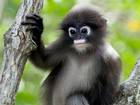Bulwer's Pheasant
Bulwer's Pheasant is sexually dimorphic. Males have a total length of about 80 centimetres (31 in), and are black-plumaged with a maroon breast, crimson legs, a pure white tail of long, curved feathers, and bright blue facial skin with two wattles that conceal the sides of its head. Females have a total length of about 55 centimetres (22 in), and are an overall dull brown colour with red legs and blue facial skin.
Lophura bulweri
Bornean Bristlehead
The Bristlehead is a medium-sized (25 centimetres (9.8 in) in length) black or dark grey bird, with red thighs and a red head, throat and neck, with grey ear-coverts and a featherless yellow crown. There is a white wing-patch, visible in flight, and females also have red spots on the flanks. It has a massive heavy black hooked bill and a short tail, giving it a chunky appearance. The crown is covered by short (3–4 mm) yellow or straw-coloured skin projections like bare feather shafts, hence the name 'Bristlehead'. Juveniles have black thighs, red ear-coverts, a red eye-ring, just a few red feathers on the head and undeveloped 'bristles'.
It is a noisy species making a variety of unmusical calls, including distinctive high-pitched nasal whining notes interspersed with harsher notes, chattering noises, whistles, honks and chortles.
Pityriasis gymnocephala
Mountain Serpent-eagle
The Mountain Serpent Eagle is a bird of prey that is found in northern Borneo. It inhabits submontane and montane evergreen rainforests. It prefers forests with height of 1,000-2,900 meters above sea level. It also prefers to be separated vertically away from Spilornis cheela by a few hundred meters whenever the two share the same area.
Spilornis kinabaluensis is threatened by habitat loss. However, they occur within the Kinabalu National Park and the Mulu National Park. Their high-altitude habitats are usually too remote for logging and agriculture, making some of its range secure.
Spilornis kinabaluensis
Dulit Partridge
The partridge is 30 cm in length. Like the Long-billed Partridge, it is mainly rufous-buff in colour, with a lavender-grey breast-band, a long, black, curved bill and yellow legs. It differs from the Long-billed Partridge in that the grey breast band is twice as wide, and the underparts are whitish-buff rather than bright orange-buff.
Rhizothera longirostris dulitensis
Red-breasted Partridge
Description: Medium-sized (32 cm), brown partridge with bold, black and white pattern on flanks. Crown and nape blackish, streaked brown; eyebrow and cheeks pale chestnut. Some birds from Sarawak have grey eyebrow and cheeks, and darker breast. Upperparts brown, narrowly barred black; bold black marks on tertiaries. Breast cinnamon; vent white. Female has browner, smaller white spots.
Iris - brown; bill - grey; bare eye-ring skin - crimson; feet - pinkish.
Voice: A repeated, ringing, rising note kuwar, uttered at a rate of about 3 per second, answered by a loud, double not cuckoo dropping in pitch, at a rate of about one per second.
Range: Endemic to Borneo.
Distribution and status: Confined to hills of N Borneo; from Mt. Kinabalu south to Usun Apau and upper Kayan, and outlier Mt. Mulu. Not uncommon in sub-montane forests from 600 to 1200 m, notably common in Kelabit highlands, also reported from Ulu Barito.
Habits: Shy, groups keep to thickets and bamboo in forest.















